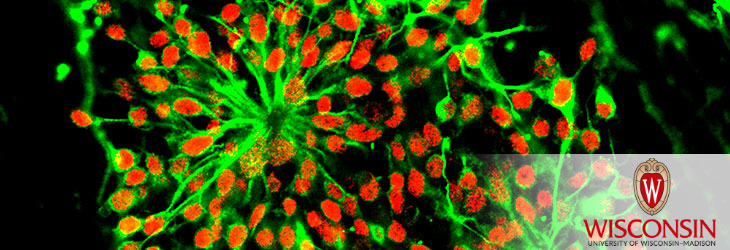Pluripotent Stem Cells

Generating Human Heart Cells via Lineage Reprogramming
WARF: P140116US02
Inventors: Timothy Kamp, Pratik Lalit
The Wisconsin Alumni Research Foundation (WARF) is seeking commercial partners interested in developing a new method to generate induced cardiac progenitor cells (iCPCs) for research and heart therapy.
Overview
Converting one type of cell to another with no intermediate pluripotent stage is called lineage reprogramming. The method has been used to ‘reprogram’ mouse fibroblasts to cardiomyocytes (heart muscle cells).
Even more desirable would be the ability to convert common human body cells into induced cardiac progenitor cells (iCPCs), which are highly proliferative and can be turned into a number of important heart cells including cardiomyocytes, smooth muscle cells and endothelial cells. These types of cells are vital for normal heart function and get damaged during heart attack. Thus, iCPCs represent a powerful tool for cardiac research and regeneration.
Even more desirable would be the ability to convert common human body cells into induced cardiac progenitor cells (iCPCs), which are highly proliferative and can be turned into a number of important heart cells including cardiomyocytes, smooth muscle cells and endothelial cells. These types of cells are vital for normal heart function and get damaged during heart attack. Thus, iCPCs represent a powerful tool for cardiac research and regeneration.
The Invention
UW–Madison researchers have developed a method to reprogram human (or other mammalian) somatic cells to iCPCs by defined factors. The factors include several early cardiac transcription factors and a chromatin remodeling factor. They may be introduced into the cell via standard vector techniques. Successfully reprogrammed cells are separated from the others and cultured in a proliferative state.
Applications
- Generating induced cardiac progenitor cells
- Subsequent differentiation into cardiovascular lineage cells
Key Benefits
- iCPCs are proliferative and multipotent.
- Method provides a valuable source of cells for research and regenerative medicine.
- Sidesteps technical difficulties/ethical concerns involving stem cells
- Unlike other methods, cells never go through a pluripotent state.
Stage of Development
Human iCPCs produced by the new method have been shown to be multipotent and capable of differentiation into cardiomyocytes, smooth muscle cells and endothelial cells.
Additional Information
For More Information About the Inventors
Related Technologies
Tech Fields
For current licensing status, please contact Andy DeTienne at [javascript protected email address] or 608-960-9857